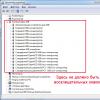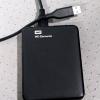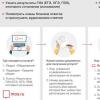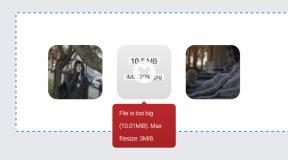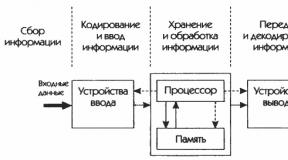Windows was unable to complete the update. Error: We were unable to configure Windows updates. Why does the computer write “Windows updates could not be configured”: reasons and solutions to the problem
From the first minutes of working on a computer, each user slowly discovers a completely new world of computer capabilities. It has a place for the endless expanses of the Internet, and a bunch of cutting-edge programs, applications, games, thanks to which life becomes much simpler and more interesting. At the same time, the computer “honeypot” also has its own fly in the ointment in the form of system failures, glitches and errors, the elimination of which sometimes makes your head spin. What should you do if Windows 7 updates are not installed on your PC? How can one explain this behavior of his?
Reason #1: Incorrect download of updates
As practice shows, the Windows 7 update package is most often not installed on the system due to problems with loading it. The essence of the process is that initially it is downloaded into the cache and stored there until the user gives the go-ahead to the Windows Update service to install these files on the computer.
As a result, if downloaded incorrectly, it becomes impossible to install them on the system. At the same time, a new attempt to download updates will also be unsuccessful, because the cache that Windows 7 accesses will display files downloaded with an error.
What is the way out of this situation? Right! Delete updates from the cache, download them again and then install them on your computer without any problems. Our favorite command line will help us with this. We launch it through the “Start” menu by typing three English letters cmd and clicking the mouse on the value that appears in the “Programs” line:

After this, enter the following commands into the command line, alternating with pressing Enter:
- net stop wuauserv
- ren %windir%\SoftwareDistribution SoftwareDistribution.OLD
- net start wuauserv

Having completed them, go to the “Update Center...” and manually update the system. If desired, you can also remove previously installed problematic files from the update package here:

Reason #2: Windows Registry Problems
More than half of all failures in installing updates on 7 are accompanied by the appearance of error 80070308, which in turn can be caused by incorrect operation of the Windows registry.
How to deal with this problem? First, you need to open the “Run” utility by pressing +R, enter the regedit command into it and click the OK button. Next, go to the HKEY_LOCAL_MACHINE section, select the COMPONENTS tab and delete the PendingRequired item in it:

After this, all that remains is to restart the system and download the updates again.
Reason #3: The update service failed
Problems installing updates on a computer running Windows 7 can also be caused by problems with the corresponding service. How to bring her back to life? To begin, enter the search query “Services” in the “Start” menu and click on the appropriate program in the list that appears. Then, in the list of services that appears, you need to find the “Update Center...” tab, click on it and stop the service by clicking the “Stop” button:

Next, without closing the system window, you will need to find the SoftwareDistribution folder on your hard drive in the Windows directory and manually delete all the data stored in it. After this, you need to return to the “Services” window, find the “Update Center…” item again, right-click on it and select the “Run” option. Having done this, all that remains is to restart the computer and search for and install updates.
Note that the Fix it utility can also help in this case:

It works automatically, so there should not be any difficulties when working with it. If that doesn't help, try performing a system rollback:

Other reasons and solutions
No matter how trivial it may sound, errors in installing updates on a PC with Windows 7 can also be associated with a lack of free space on the hard drive. So, in order for the system to be fully updated without the appearance of scary messages about system failures, you need to have at least 5 Gb of free memory on your hard drive. If the mark moves towards this indicator, you don’t even have to ask why the system suddenly froze when installing updates, and I can’t do anything with it at all.
What could be the solution? It’s easier, of course, to delete unnecessary files from the hard drive and forget about the problem. If this is not possible, you will either have to abandon the idea of updating, or buy a removable hard drive and put all the information on it. But maybe we should still remove the unnecessary stuff, huh?
Meanwhile, problems with updating Windows 7 may also arise due to a lack of Internet connection or proxy server errors. The solution here is simple - check the Internet settings, reconnect to the network and update the system. At the same time, it would be a good idea to check the operation of the antivirus program / firewall: whether it accidentally blocks update files and access to the Microsoft website. If this is the case, you will need to either disable it temporarily or remove it if the process repeats.
Some Windows users like to reinstall the operating system when they are unable to cope with the situation and find a solution to the problem on their own. For example, if an attempt to deploy an update fails, the computer goes into a looping reboot mode, followed by the message “We were unable to configure Windows updates. Changes are being rolled back" or "We were unable to complete the updates. Cancel changes. Don't turn off your computer." The legs of both one and the other have been growing since Windows 7 and they still won’t be cut off in the “top ten”. But you can still overcome them, and to do this it is not at all necessary to tear down the system and install it again. Just read these instructions, which describe what needs to be done if the OS is unable to install the Windows 10 update.
Cleaning out the SoftwareDistribution folder with Windows 10 updates
Before installing updates, the system downloads them to a separate directory. In most cases, cleaning it or moving it will help overcome the mentioned errors. This can be done either from under the system (if you have access to it) or using a USB drive with files for installing Windows 10.
Cleaning up the SoftwareDistribution folder in
This method is suitable if you managed to log in.

Using a bootable Windows 10 USB flash drive to clean SoftwareDistribution
If you cannot get into the system, then to clear the folder you will have to use the drive with the files to install the operating system. you can do it in several ways, but one way or another you will need a second computer with a stable operating OS.
After creating the boot drive, do the following:

Fixing Windows Update Could Not Complete Error with Update Center Diagnostics
As you may know, Windows has its own set of diagnostic and troubleshooting tools. You've probably come across it often, but never used it. Now you have a great opportunity to use it to solve the problem.

If you are unable to penetrate the system, then you should try another option.

Removing a duplicate profile to fix Windows Updates Could Not Complete Error
In some cases, the Windows 10 update installation process may fail due to a duplicate user account. The Registry Editor will help you fix this problem. Be careful and do not touch anything unnecessary so as not to harm the system.

If there is no change for the better after applying all the described methods, you can try saving the data.
Each Windows product has its own life cycle. It begins when the system is first released and ends when its support and bug fixes cease. Windows 7 is no exception, and will continue to receive updates for a couple of years. In this article, we will look in detail at the main reasons why updates are not installed in Windows 7 and how to fix this problem.
Description of the problem
Microsoft ended support for Windows 7 in 2015. But despite this, the release of security updates and system error fixes will last until January 2020. Therefore, the problem when updates do not start, do not download, or an endless search for them appears is quite common and popular.
It is often associated with system problems or failures of various system components or services, but viruses should not be ruled out either. A full scan of your computer for threats and further cleaning may help, but is not a 100% guarantee.
Why Windows 7 updates won't install?
The main reasons for problems downloading and installing updates on the OS:
- Problems with downloading. Initially, files are downloaded into cache memory and stored there until the user allows their installation or restarts the computer. If they are downloaded with errors, installation of updates on the computer is impossible. Unfortunately, when you download update files again, the data is not updated.
- Windows registry problems. Often when installing updates, the problem is hidden in a failure of the registry settings or incorrect parameters set in the registry.
- The Windows Update service has failed.
- Lack or limited amount of free memory on the system disk. A fairly common problem, because if the required space on the hard drive is small, the update will not be installed or will be installed with errors.
- No internet or blocked by installed antivirus. Very often, the antivirus blocks files unknown to it. Disabling it while the update is downloading will solve this problem.
- Blocked by a virus.
What to do if Windows 7 won't update
If Windows 7 does not install updates or is endlessly searching for them, the first thing you need to do is use Microsot’s “Fix It” utility. Once launched, it will automatically fix all problems related to the update center. You can download the utility from the official website using the link.
Let's look at the main methods to fix the problem.
Clearing cached files
If the reason is downloading updates with errors, you need to clear the downloaded update files located in the cache memory. And only then download them again. To do this you should:

Registry settings
The problem with the OS registry can be resolved by removing the component responsible for updates. Follow these steps:

Starting OS services
If the installation of an update fails in Windows 7, the problem may be in a system service and can be resolved by performing the following steps:
- Click “Start” → in the search, write “Services” → open this window.

- In the window that appears, look for a service with the name «
Windows Update." If the service is disabled, click “Run” and the problem will be solved.

- If the service is started and running, click “Stop”.

- Launch the “Command Prompt” by pressing “Win + R” → type the command “SoftwareDistribution” → “OK”.

- In the window that appears, delete all folders and files.

- Next we start the service « Windows Update » (point 2) and reboot the PC.
- Go to the update center and install updates without previous errors.
If you do not have a specific update installed (the example of the update “kb2999226” is considered), you need to enter the name of the update in the search field on the site, download it and install it on your computer.
Microsoft regularly releases updates for Windows 10: some of them are global in nature and add new functionality to the system, others affect the operation of internal system components that are invisible to the average user. But what users always notice is notifications about a forced restart of the computer to install updates. Very often this process occurs at the most inopportune moment, which can lead to the loss of data and nerve cells of the user.
But this is half the trouble; the moments are especially wonderful when, after agonizingly waiting for an update to be installed, Windows reports that these updates were not installed. What to do in such cases?
The first step is to check the “Update Log” - this is a special log where information about all update packages that your computer receives is saved. Go to Action Center > All Settings > Update & Security > Windows Update > Update History.

Analyze the list that appears in front of you. You'll likely see numerous "Failed to install" errors next to most packages. Their reasons for each individual update package should be considered individually, but very often they are united by the fact that the elements for which Windows is trying to install updates are simply not in the system. This happens in cases where an unlicensed version of Windows is installed, where the authors of the “assembly” kindly deleted some system files, or if the user himself deleted system files in Windows 10. In such cases, only a complete reinstallation of Windows or disabling automatic updates will help so that the system I didn’t try to constantly update something that doesn’t exist.
If the version of Windows 10 you are using is guaranteed to be licensed, and no one has ever touched the system files, then you need to check the operating system for errors. Open a command prompt as an administrator and enter the command sfc /scannow. If Windows finds damaged files, it will fix them.

The second reason why updates cannot be installed may be that the update files themselves are damaged. This can happen due to a poor Internet connection, a Microsoft error, or due to a break in the update download session. You can delete downloaded files by going to the directory c:/windows/SoftwareDistribution/Download/. After deleting the files, it would be a good idea to clean the registry using special software, and then start downloading updates from Windows Update manually.

Windows is too complex an operating system to provide universal instructions for solving problems with updates. As mentioned above, a reliable assistant for finding the main reason for the inability to install updates is a log that will tell you which specific element of the system cannot be updated.
This problem is not something supernatural and insoluble. Any problem can be solved. First of all, you need to understand the cause of the system problems. In order to solve the consequences of a “breakdown”. There are two main reasons.
The first of the main reasons for almost all users is simple forgetfulness.
Users often forget about automatic system updates and simply turn off the computer when downloading the update. Which leads to a system error. Also in case of unauthorized power outage.
The second reason, the most common, is the use of pirated content.
When downloading updates to Microsoft services, the code is identified. Let's just say checking the Windows system license. Which leads to this problem.
Practical actions to solve the problem!
method one.
If, when you start Windows_7 or Windows_XP, the principle of operation in the systems is almost the same, when you try to install updates, the system writes that “it was not possible to configure windows updates” and “the changes are being canceled.” In this case, a reboot occurs and the system starts updating windows again. This can happen ad infinitum. The following actions must be taken:
You need to restart the computer, or, as in our case, wait for a reboot. Or press the “RESET” button. On a laptop, hold down the power button.
While loading the bios, you must press the “F-8” key. The system boot menu opens.
From the list, select “Safe Mode” and wait for the system to boot.
In Safe Mode, most system services are disabled. Therefore, this method allows you to disable the update download system. On the desktop, go to the start menu.
Click “Computer”.
Select “local disk (C)”. If the drive letter on which the system is installed is different, then select your local drive.
Then we follow the following path:
From:/windows/SoftwareDistribution/Download/
The "Download" folder contains Microsoft update files for windows.
The downloaded update files must be deleted from the package. Select files by date and time that were downloaded the last time they were updated. If this is difficult for you. Select all files and folders with the mouse and delete. After deleting, reboot the system and try to enable system updates.
If you have pirated Windows content installed, it is recommended to disable system updates in the system settings. In order to protect yourself from such problems.
Method two.
If the first case did not work for some reason. You can restore your system using a system backup restore point. We do almost the same thing.
When the system boots, press “F-8”. Select "Safe Mode with Command Line Support". Press “enter”. In the command line, enter the following command “msconfig”, press “enter”. You will be taken to the “system configuration” window
Select “service” at the top of the window. In the window that opens, select “restore the computer system to one of its previous states”
The System Restore window opens. Click “next”.
Confirm the restore point. Click “Finish”.
After which you need to confirm the restoration notification. Click “Yes”. After the system restore is complete. Try updating the system again or disabling the update in the settings.
method three.
If the previous two methods did not help you. And they didn’t bring you any closer to solving the problem. You need to do the following: As you probably already remember.
Reboot the computer. During loading, press “F-8”. In the download lists, select “Directory Services Restore Mode”.
Important: Turn off the Internet.
After the procedure, the system should turn on.After the procedure, the system should turn on. Go to the start menu. In the "control panel".
In the "control panel". If your control panel looks different, change it to the format you need in the “view” category in the upper right corner.
Go to Windows Update. In the window that opens, on the left side select “Parameters settings”.
In the settings, uncheck all the boxes.
We also change “Install automatically (recommended)” to “Do not check for updates (not recommended).” Then try to restart your computer.
If this article helped you solve your problem. So you didn't waste your time.





